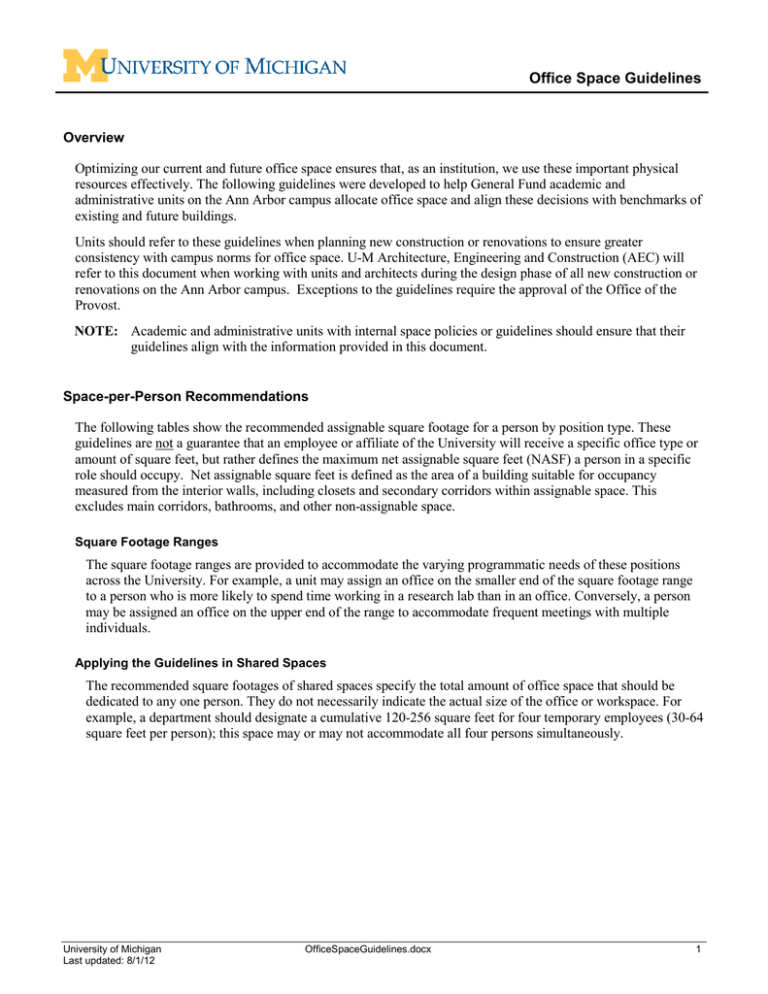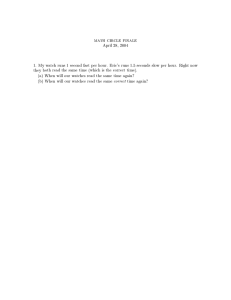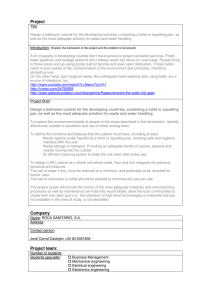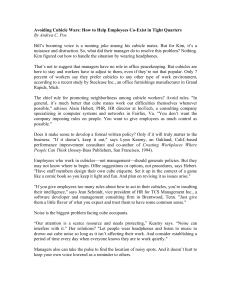Office Space Guidelines - Office of the Provost
advertisement

Office Space Guidelines Overview Optimizing our current and future office space ensures that, as an institution, we use these important physical resources effectively. The following guidelines were developed to help General Fund academic and administrative units on the Ann Arbor campus allocate office space and align these decisions with benchmarks of existing and future buildings. Units should refer to these guidelines when planning new construction or renovations to ensure greater consistency with campus norms for office space. U-M Architecture, Engineering and Construction (AEC) will refer to this document when working with units and architects during the design phase of all new construction or renovations on the Ann Arbor campus. Exceptions to the guidelines require the approval of the Office of the Provost. NOTE: Academic and administrative units with internal space policies or guidelines should ensure that their guidelines align with the information provided in this document. Space-per-Person Recommendations The following tables show the recommended assignable square footage for a person by position type. These guidelines are not a guarantee that an employee or affiliate of the University will receive a specific office type or amount of square feet, but rather defines the maximum net assignable square feet (NASF) a person in a specific role should occupy. Net assignable square feet is defined as the area of a building suitable for occupancy measured from the interior walls, including closets and secondary corridors within assignable space. This excludes main corridors, bathrooms, and other non-assignable space. Square Footage Ranges The square footage ranges are provided to accommodate the varying programmatic needs of these positions across the University. For example, a unit may assign an office on the smaller end of the square footage range to a person who is more likely to spend time working in a research lab than in an office. Conversely, a person may be assigned an office on the upper end of the range to accommodate frequent meetings with multiple individuals. Applying the Guidelines in Shared Spaces The recommended square footages of shared spaces specify the total amount of office space that should be dedicated to any one person. They do not necessarily indicate the actual size of the office or workspace. For example, a department should designate a cumulative 120-256 square feet for four temporary employees (30-64 square feet per person); this space may or may not accommodate all four persons simultaneously. University of Michigan Last updated: 8/1/12 OfficeSpaceGuidelines.docx 1 The following space-per-person recommendations are based on recent construction projects at the University and on space guidelines from other higher education institutions and the private sector. They were developed in collaboration with the Office of the Provost; Architecture, Engineering and Construction; and various administrative and academic units. NOTE: The types of room occupants listed below do not reflect official U-M job titles or classifications. They are listed strictly for the purpose of showing the relationship between role, space type, and net assignable square feet (NASF). The information is only to be used when making office space related decisions. Types of Room Occupants Space Type Recommended NASF per Person Executive President Vice President Private Office Private Office 400 300 Academic Units Dean Associate or Assistant Dean Department Chair Faculty, Tenure Track Faculty, Research 1 Faculty, Non-Tenure Track (e.g. Lecturer III & IV) Faculty, Visiting or Consulting Faculty, Emeritus (Active) Faculty, Emeritus (Non-active) 1 Fellow, Lecturer I & II, Visiting Scholar Unit Administrative Manager Technician, Associate, or Specialist (Research) Research Fellow Staff, Professional (Full-time) 2 Staff, Professional (Part-time) Staff, Administrative Support (Full-time) 2 Staff, Administrative Support (Part-time) 1 Graduate Student Instructor 1 Graduate Student Research Assistant Temporary or Student Staff Private Office Private Office Private Office Private Office Private Office Private Office, Shared Office, or Cubicle Shared Office or Cubicle Private Office, Shared Office, or Cubicle Shared Office or Cubicle Shared Office or Cubicle Private Office Private Office, Shared Office, or Cubicle Shared Office or Cubicle Private Office, Shared Office, or Cubicle Shared Office or Cubicle Shared Office or Cubicle Shared Office or Cubicle Shared Office or Cubicle Shared Office or Cubicle Shared Office or Cubicle 240 160 160 100-160 100-160 80-100 80 64-140 30-64 80 100-160 30-100 30-80 64-100 80 64-100 64-80 30-64 30-64 30-64 Private Office Private Office Private Office Private Office, Shared Office, or Cubicle Private Office, Shared Office, or Cubicle Shared Office or Cubicle Shared Office or Cubicle Shared Office or Cubicle Shared Office or Cubicle 160-240 100-160 100-140 80-140 64-100 80 64-100 64-80 30-64 Administrative Units Associate or Assistant Vice President Director Associate or Assistant Director Manager Staff, Professional (Full-time) 2 Staff, Professional (Part-time) Staff, Administrative Support (Full-time) 2 Staff, Administrative Support (Part-time) Temporary or Student Staff 1 The University is obligated to provide space appropriate for assigned employment functions to members of the Lecturers Employee Organization (LEO) and Graduate Employees Organization (GEO), as defined in their contracts. Contact your unit’s labor relations representative if questions about space assignments arise. 2 Part-time denotes the room occupant is 50% FTE or less. If the occupant is more than 50% FTE, it is recommended to follow the guidelines for a full-time room occupant. University of Michigan Last updated: 8/1/12 OfficeSpaceGuidelines.docx 2 Private Offices, Shared Offices, and Cubicles Private offices are necessary for many positions at the University. The size of the office varies depending on the type of work and the need to meet with individuals or groups frequently and in a private setting. These spaces should be able to accommodate a desk, files, bookshelves, and space to meet with an additional one to six people. The following positions would, in most cases, require private offices: Executive Academic Administrative President Vice President Dean Associate or Assistant Dean Department Chair Faculty, Tenure Track Faculty, Research Unit Administrative Manager Associate or Assistant Vice President Director Associate or Assistant Director Some positions in a unit or department may require private office space, while a person with similar duties in another unit or department may not. The following positions should be allocated private office space on a caseby-case basis: Academic Administrative Faculty, Non-Tenure Track (e.g. Lecturer III & IV) Staff, Professional (Full-time) Faculty, Emeritus (Active) Technician, Associate or Specialist (Research) Manager Staff, Professional (Full-time) Shared offices, cubicles, and open workspaces are an efficient use of office space. Shared offices should be assigned to individuals who require a certain amount of privacy or reduced noise levels. Cubicles and open workspaces are particularly space-efficient, flexible, and can accommodate additional guests as needed. The following positions would, in most cases, be assigned a shared office, cubicle or open workspace: Academic Administrative Faculty, Visiting or Consulting Research Fellow Fellow, Lecturer I & II, Visiting Scholar Faculty, Emeritus (Non-active) Staff, Administrative Support (Full-time) Staff, Administrative Support (Part-time) Staff, Professional (Part-time) Graduate Student Instructor Graduate Student Research Assistant Temporary or Student Staff Staff, Administrative Support (Full-time) Staff, Professional (Part-time) Staff, Administrative Support (Part-time) Temporary or Student Staff University of Michigan Last updated: 8/1/12 OfficeSpaceGuidelines.docx 3 Special Circumstances Multiple Offices Assignment of multiple offices for faculty and staff is strongly discouraged, unless there is a true demonstrated need. Faculty with joint appointments and persons with staff in multiple buildings may be assigned a secondary office, provided it is not located within the same building as the primary office. A secondary office can be shared or private; however, it should be smaller than the primary office. A size of 80 to 160 square feet is recommended. All decisions related to multiple offices should be made on a case-by-case basis. Use of Unoccupied Offices One significant way to reduce the shortage of office space is to ensure that all offices are occupied throughout the year. When offices are left unoccupied for significant periods of time, such as during sabbaticals or other leaves, units and departments should use these spaces to alleviate any pressing space needs. Emeritus Faculty Offices Emeritus faculty may be provided shared offices, if space is available within a unit, as long as they remain engaged in unit activities. These shared offices are intended to allow an individual to maintain contact with their unit, discipline and colleagues. An emeritus faculty member actively engaged in teaching or research may retain a private office at the discretion of the unit, if space is available. Questions about these guidelines should be directed to space.utilization@umich.edu. University of Michigan Last updated: 8/1/12 OfficeSpaceGuidelines.docx 4





